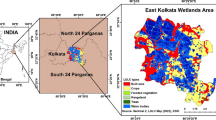Abstract
Runoff coefficients are usually considered in isolation for each drainage area with resulting large uncertainties in the areas and coefficients. Accurate areas and coefficients are obtained here by optimizing runoff coefficients for characteristic Geographic Information Systems (GIS) subareas within each drainage area so that the resulting runoff coefficients of each drainage area are consistent with those obtained from runoff and rainfall volumes. Lack of fit can indicate that the ArcGIS information is inaccurate or more likely, that the drainage area needs adjustment. Results for 18 drainage areas in Milwaukee, WI for 2000–2004 indicate runoff coefficients ranging from 0.123 for a mostly residential area to 0.679 for a freeway-related land, with a standard error of 0.047. Optimized runoff coefficients are necessary input parameters for monitoring, and for the analysis and design of in situ stormwater unit operations and processes for the control of both urban runoff quantity and quality.




Similar content being viewed by others
References
Adams BJ, Papa F (2000) Urban stormwater management planning with analytical probabilistic models. Wiley, New York, p 376
Alley WM (1981) Estimation of impervious-area washoff parameters. Water Resources Research 17(4):1161–1166
Boyd MJ, Bufill MC, Knee RM (1993) Pervious and impervious runoff in urban catchments. Hydrological Sciences Journal—Journal Des Sciences Hydrologiques 38:463–478
Boyd MJ, Bufill MC, Knee RM (1994) Predicting pervious and impervious storm runoff from urban drainage basins. Hydrological Sciences Journal—Journal Des Sciences Hydrologiques 39:321–332
Brezonik PL, Stadelmann TH (2002) Analysis and predictive models of stormwater runoff volumes, loads, and pollutant concentrations from watersheds in the Twin Cities metropolitan area, Minnesota, USA. Water Research 36:1743–1757
Bronstert A, Niehoff D, Burger G (2002) Effects of climate and land-use change on storm runoff generation: present knowledge and modelling capabilities. Hydrological Processes 16:509–529
Cristina CM, Sansalone JJ (2003) Kinematic wave model of urban pavement rainfall-runoff subject to traffic loadings. Journal of Environmental Engineering 129:629–636
Dewan AM, Islam MM, Kumamoto T, Nishigaki M (2007) Evaluating flood hazard for land-use planning in Greater Dhaka of Bangladesh using remote sensing and GIS techniques. Water Resources Management 21:1601–1612
Eriksson E, Baun A, Scholes L, Ledin A, Ahlman S, Revitt M, Noutsopoulos C, Mikkelsen PS (2007) Selected stormwater priority pollutants—a European perspective. Science of the Total Environment 383:41–51
Hipp JA, Ogunseitan O, Lejano R, Smith CS (2006) Optimization of stormwater filtration at the urban/watershed interface. Environmental Science & Technology 40:4794–4801
Kayhanian M, Suverkropp C, Ruby A, Tsay K (2007) Characterization and prediction of highway runoff constituent event mean concentration. Journal of Environmental Management 85:279–295
Kim LH, Kayhanian M, Zoh KD, Stenstrom MK (2005) Modeling of highway stormwater runoff. Science of the Total Environment 348:1–18
Lee JG, Heaney JP (2003) Estimation of urban imperviousness and its impacts on storm water systems. Journal of Water Resources Planning and Management 129:419–426
Lee H, Swamikannu X, Radulescu D, Kim SJ, Stenstrom MK (2007) Design of stormwater monitoring programs. Water Research 41:4186–4196
McCuen RH (1981) Relation between curve number and runoff coefficient. Journal of the Irrigation and Drainage Division 107:395–400
McCuen RH (1998) Hydrologic analysis and design, 2nd edn. Pearson Prentice Hall, New Jersey
McCuen RH (2004) Hydrologic analysis and design, 3rd edn. Pearson, Prentice Hall, p 888
Niehoff D, Fritsch U, Bronstert A (2002) Land-use impacts on storm-runoff generation: scenarios of land-use change and simulation of hydrological response in a meso-scale catchment in SW-Germany. Journal of Hydrology 267:80–93
Park MH, Stenstrom MK (2006) Spatial estimates of stormwater-pollutant loading using Bayesian networks and geographic information systems. Water Environment Research 78:421–429
Sartor JD, Boyd GB, Agardy FJ (1974) Water pollution aspects of street surface contaminations. Journal of Water Pollution Control Federation 46(3):458–467
Sen Z, Altunkaynak A (2006) A comparative fuzzy logic approach to runoff coefficient and runoff estimation. Hydrological Processes 20:1993–2009
Seth I, Soonthornnonda P, Christensen ER (2006) Use of GIS in urban storm-water modeling. Journal of Environmental Engineering 132:1550–1552
Soonthornnonda P (2007) Stormwater quality characterization, modeling, and management for the greater Milwaukee area, Wisconsin. Ph.D. Dissertation, University of Wisconsin-Milwaukee, Milwaukee
Soonthornnonda P, Christensen ER (2008) A load model based on antecedent dry periods for pollutants in stormwater. Water Environment Research 80(2):162–171
Southeastern Wisconsin Regional Planning Commission (SEWRPC) (2000) GIS landuse inventory. Waukesha, WI
U.S. Geological Survey (2004) Water-resources-related information for the Milwaukee metropolitan sewerage district planning area, Wisconsin, 1970–2002. Water-Resources Investigation Report 03-4240, USGS, Reston, Virginia
United States Geological Survey Digital Elevation Models (USGS DEMs) (2000) U.S. Department of the Interior, U.S. Geological Survey. http://edc.usgs.gov/products/elevation/dem.html
Weng QH (2001) Modeling urban growth effects on surface runoff with the integration of remote sensing and GIS. Environmental Management 28:737–748
Wong TSW (2002) Call for awakenings in storm drainage design. Journal of Hydrologic Engineering 7:1–2
Acknowledgments
This work was supported by the Milwaukee Metropolitan Sewerage District (M03023E01). We thank Urbain Boudjou, Mary Singer, Christopher Magruder, Sara Hackbarth, and Sarah Seifert for helpful discussions.
Author information
Authors and Affiliations
Corresponding author
Appendix A
Rights and permissions
About this article
Cite this article
Liu, Y., Soonthornnonda, P., Li, J. et al. Stormwater Runoff Characterized by GIS Determined Source Areas and Runoff Volumes. Environmental Management 47, 201–217 (2011). https://doi.org/10.1007/s00267-010-9591-2
Received:
Accepted:
Published:
Issue Date:
DOI: https://doi.org/10.1007/s00267-010-9591-2




